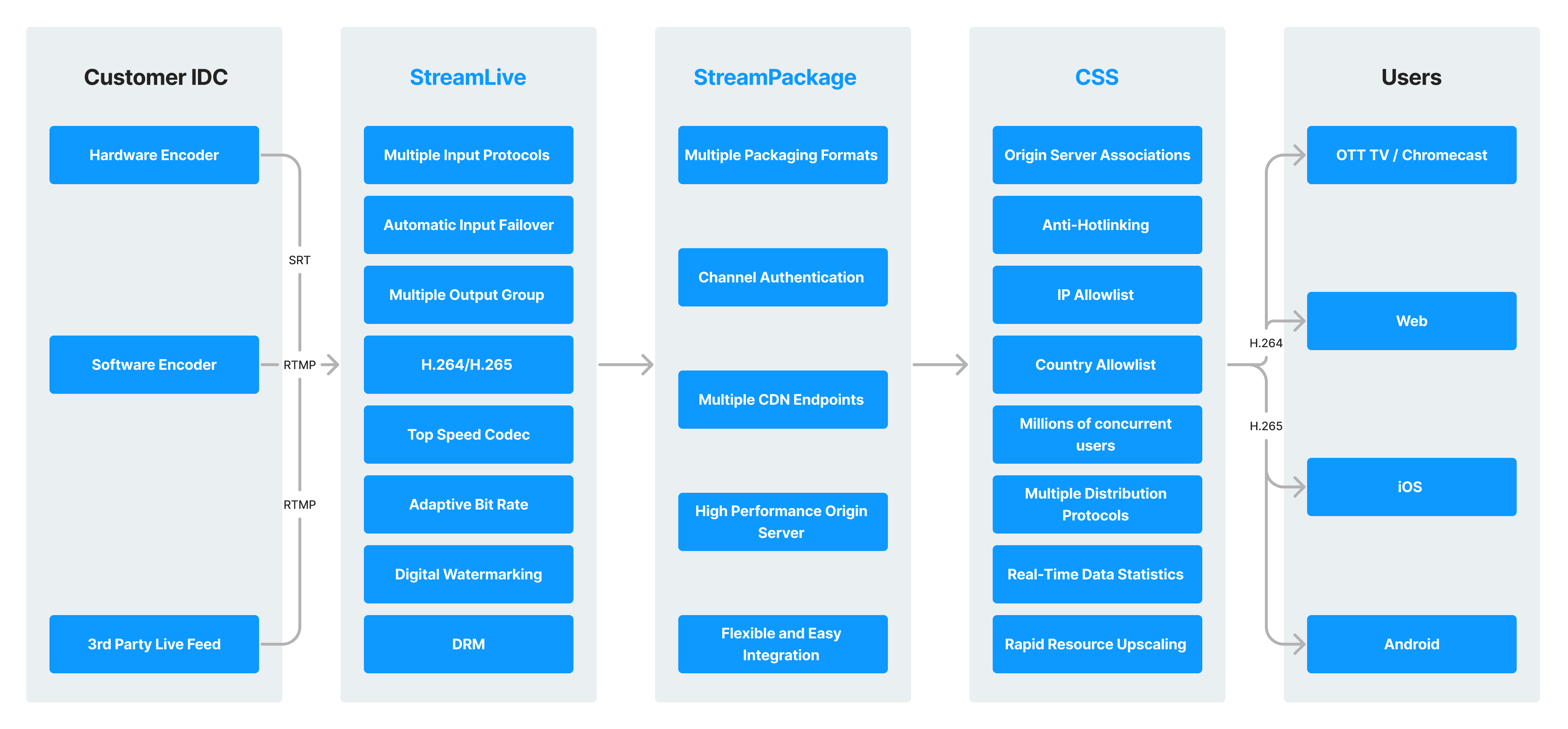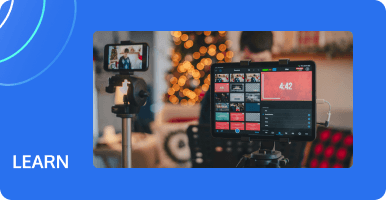How to build an OTT live streaming platform for FIFA World Cup sports?
In recent years, video live streaming applications have been thriving. Tencent Cloud, based on its rich experience accumulated over the years in large-scale sports events, concerts, and eSports events such as League of Legends, has integrated the ultimate encoding kernel, stable and efficient media transmission technology, diverse media processing, powerful AI capabilities, and the technical accumulation of large-scale streaming media systems. It has built an integrated solution from the video source acquisition end to the playback end to ensure the ultimate viewing experience for users in ott live streaming scenarios. This solution can help enterprises quickly build a stable, reliable, high-definition, low-code, media processing, online directing ultra-low latency ott live streaming platform. It has played a leading role in the industry and achieved rapid growth together with customers.

This article uses the example of live streaming the World Cup to illustrate how to provide customers with stable and high-quality ott live streaming services. The case study focuses on an OTT video platform that we have been serving for multiple years. The platform not only handles live streaming for the FIFA World Cup but also for the Cricket World Cup. The platform broadcasts over 100 matches, with simultaneous online viewership exceeding millions. Additionally. We have provided the customer with a stable and comprehensive end-to-end solution for all their needs. The customer has high expectations for video quality, and after testing our MPS (Media Processing Service) product capabilities, the result indicates that the quality of the low-resolution video after being transcoded by MPS is comparable to the high-resolution video provided by their previous service provider. This achievement received high praise from the customer.
Live Streaming Core Requirements
- Given that the World Cup audience is spread across the globe, the stability of the service is crucial. We need to ensure that we can provide stable and smooth ott live streaming services in any geographical location and under any network conditions.
- To allow global audiences to watch the matches in real-time and synchronously, low-latency live broadcasting of the matches is a basic requirement for viewers, ensuring that match information can be delivered to the audience in the shortest possible time.
- When conducting live broadcasts of events with over a million online viewers, it's necessary to effectively compress the video size while also ensuring picture quality, in order to reduce the bandwidth costs borne by the enterprise.
- In addition to regular live streaming services, capabilities such as recording, playback, and highlight clipping are also needed to meet the demands of different viewers. It's also necessary to handle various formats and resolutions to suit different devices and network environments.
- In terms of the security, privacy, and copyright protection of live broadcast content, it's necessary to strictly comply with relevant laws and regulations, protect content copyright interests, and implement effective content encryption and access control strategies.
World Cup Live Streaming Solution

Based on the core requirements of our clients mentioned above, we provide customers with global streaming media products Stream Services, including StreamLink, StreamLive, StreamPackage, and Cloud Live Streaming (CSS), combined with Tencent's global leading Media Processing Service (MPS) capabilities, to provide users with a one-stop streaming media service solution.
- StreamLink can provide cross-region media transmission and protocol conversion. Through dedicated lines, dynamic scheduling, and optimization of transmission protocols, the intercontinental transmission delay is compressed to the millisecond level.
- StreamLive integrates Tencent Cloud's ultra-fast, high-definition, high-performance intelligent encoding, has broadcasting-level media processing capabilities, supports the current mainstream streaming media protocols, enhances stability through input lossless disaster recovery switching and continuous dynamic frame supplementation, and adapts to multi-channel distribution needs.
- StreamPackage further provides rich media packaging capabilities, can be connected to CSS with one click, and carry out global streaming media distribution. At the same time, it supports the capability of server-side dynamic ad insertion (SSAI) through advertising insertion and delivery standards based on SCTE-35 and VAST/VMAP.
- Live Event Broadcasting (LEB) based on the WebRTC protocol has the ability to distribute on a large scale and ultra-low latency worldwide. The innovative feedback server-side ABR technology ensures a smooth playback experience for end-users under different network conditions.
- MPS, with a globally leading self-developed intelligent encoding kernel, has more than a hundred new generation international encoding and decoding patents in its core video processing engine. It has leading advantages in encoding technology, real-time audio and video quality enhancement, openness of media framework, and ecosystem, meeting the video processing needs of enterprises in various scenarios. Combined with AI capabilities, Tencent Cloud Media Processing (MPS) can implement dynamic encoding according to different video scenarios, saving enterprises 50%+ storage and bandwidth costs without losing subjective video quality.
Low Latency and High Quality
The audience of the event is spread all over the world. It is necessary to remotely transmit the original audio and video signals to the production center, then process and distribute them through the cloud after secondary production, and finally reach the audience's player. Tencent Cloud Media Transmission (StreamLink) provides the ability to transmit audio and video data stably and with low latency across regions. Customers can use StreamLink to achieve low-latency media transmission between two places, solving the problem of low-latency stable transmission from the scene to the production center. The transmission of 100Mbps audio and video data under rtt=200ms can control the delay stably within 500ms. LEB based on WebRTC provides an ultra-low latency playback experience within 1s. Ultra-low latency LEB based on WebRTC comprehensively optimizes and upgrades the end-to-end signaling process, support for audio and video encoding formats, transmission transformation, optimization of media processing sources, etc., which is more suitable for large-scale live broadcast scenarios.
In addition, the CMAF and LHLS low-latency slicing packaging protocols provided by Tencent Video Cloud Live can achieve lower latency on par with FLV while satisfying adaptive multi-bitrate. Through block encoding and Chunk transmission, the delay is reduced from the slice granularity of HLS and DASH to the Chunk level. At the same time, low-latency CMAF and LHLS based on HTTP can be directly distributed on almost all CDN platforms, with good standardization and universality.
High Stability and High Availability
In addition to high packet loss resistance, low latency transmission, and low-cost access methods, it also provides multi-path transmission capabilities. By transmitting over multiple link layers at the same time, the overall end-to-end transmission reliability and quality are improved, further enhancing the upstream push stream and the final playback end experience. The sending end makes judgments and decisions on the status of each established connection based on real-time transmission QoS and chooses the best route for data sending. This solves the problem of insufficient single network bandwidth or jitter under weak networks. For situations such as network fluctuations and insufficient bandwidth at the event site, Tencent Video Cloud Live also provides an SDK to optimize the quality of push stream transmission from the terminal to the cloud.
At the same time, media transmission also provides a multi-path solution with multiple access points. In some remote areas, when the upstream access point cannot effectively cover locally, the usual practice is to probe the speed before pushing the stream and evaluate the best quality access point. However, in the actual process, some event activities last for a long time, and the network conditions are constantly changing. This method has not been able to dynamically recognize network conditions and adjust routes in time. Tencent Cloud Media Transmission provides an upstream multi-access point solution, which can dynamically adjust routing strategies and data sending ratios based on the QoS of multiple links during live streaming, and make the downstream playback imperceptible.
Compress Bit Rate, Improve Picture Quality
During the event's audio and video encoding stage, with the help of ultra-high-definition encoding kernels based on self-developed O264/V265/TXAV1/O266 and other different standards, we can overlay ultra-high-definition intelligent perception dynamic encoding technology. This combines intelligent scene recognition, dynamic encoding matching, and picture quality enhancement and repair functions. On the basis of saving 50% bandwidth, it improves subjective picture quality and provides higher-definition streaming media services at a lower bit rate. Compared with the widely used x264/x265/libaom in the industry, the self-developed encoder has made breakthroughs in compression performance, encoding speed, bit rate control, subjective vision, and other algorithms, bringing a compression gain of 30%+.
left bitrate 3897 kbps and qs 3.817, right bitrate 2631 kbps and qs 3.877
Online Directing, Cloud Customization
We have moved the commonly used director's console in offline live broadcasts to the cloud, product called Live Video Caster (LVC), where we can easily implement event live stream switching, multi-picture mixed stream output, and other capabilities. Compared to the expensive equipment costs of offline director's consoles and the work mechanism that requires multiple professionals to cooperate, a lightweight LVC can be operated by just one person. The LVC also breaks geographical restrictions. There is no need to deploy professional directing equipment locally. As long as the live stream is pushed to the cloud, cross-regional directing can be easily carried out in the cloud, which is suitable for multi-camera switching scenarios.
The LVC supports multiple input source types such as live broadcast, on-demand, and pictures. It supports 20+ input sources, can preview and preview the input sources, switch live content as needed, and supports multi-picture layout. It supports 4 preset layouts + custom layouts, making it easy to achieve cloud mixing. The LVC can adjust the volume of the video through the mixer, freely switch the output audio content, and achieve audio and video separation. When the live stream encounters interruptions and other abnormal situations, the LVC has a backup mechanism that can automatically switch to the backup stream. The LVC also supports real-time subtitles, virtual backgrounds, and other gameplay.
Media Processing Services and AI
Tencent Cloud Audio and Video, combined with advanced AI capabilities, provides intelligent editing, content understanding, content review, and other services for massive video content. For example, real-time subtitle generation and automatic translation services in scenarios such as news broadcasts and conference live broadcasts; exciting replays and highlight marking services in sports and esports events; face blurring and safety review services in sensitive information review scenarios... Combined with cloud rendering + AIGC capabilities, the product's interactive capabilities have been innovatively upgraded, providing enterprises with more convenient cloud rendering interaction, AIGC capabilities, supporting thousands of AI live room gifts, barrage special effects, and other interactive new gameplay.
Copyright Protection and Live Broadcast Security
In terms of live broadcast security, Tencent Cloud also provides a variety of live broadcast encryption technologies, effectively reducing piracy and link theft, ensuring live broadcast security, specifically including Referer anti-theft chain, URL authentication encryption, DRM encryption, HTTPS encryption, IP blacklist/whitelist, regional control, remote authentication, and so on. For the widely used FLV live broadcast, Tencent Cloud Live has specially launched a self-developed FLV stream encryption solution. Tencent Cloud encrypts the live stream according to the specified module. When decrypting and playing, the customer requests to obtain the token key field through the Tencent Cloud API interface, adds it to the playback URL, and provides it to the playback SDK for decryption and playback.
Live Streaming Project Retrospective
Through the adaptive bitrate output capability based on HLS/DASH/CMAF, it can meet the network conditions of different playback ends. Based on multi-track capabilities, viewers from different language regions can freely choose when watching the same channel. Intelligent live time-shifting supports real-time playback on the basis of live broadcasting, with a time-shift span of 7 days. At the same time, it has become intelligent. With the help of various DRM encryption schemes such as Fairplay, Widevine, and PlayReady, the security of live broadcasts is enhanced. Also, during the brief interruption of the source stream, a static image or a pre-uploaded advertisement can be automatically filled in to optimize the viewer's viewing experience.
Based on this, the delivery achieved a reliable sports live broadcast platform, including automatic fault transfer of input, hot link prevention, geographic blocking, etc. High-level copyright content protection solutions, DRM, digital watermarking. Multi-protocol adaptive bitrate streaming media, fully compatible with smart TVs/PCs/mobile devices. Low-resolution videos have high-resolution video quality, etc.
Tencent Cloud Ecological Cooperation
As a cloud service provider, we aim to provide customers with high-quality and easy-to-use audio and video products. Our goal is to provide customers with a one-stop solution that is quick to integrate, offering high cost-performance services. Our encoders can reduce bitrate compression by 30-40%, saving customers bandwidth and transmission costs. Tencent Cloud has been deeply involved in the audio and video field for over 20 years, accumulating a wealth of practical experience, profound self-developed technology, and abundant underlying resources.
Currently, Tencent Cloud covers more than 100 countries and regions worldwide, providing over 3200 access nodes, 160T peak bandwidth reserves, and 15T anti-attack capabilities, which can keep the transmission delay of live broadcasts within 1 second. Different industry standards, such as SRT, QUIC, RIST, ZIXI, Dolby Vision, Dolby Atmos, etc., have also begun to integrate our products. Based on this, we have built a complete media solution for global developers, from video encoding and decoding, media AI processing, on-demand live streaming, CDN, virtual XR shooting to innovative immersive streaming media services, to meet the full-scene audio and video capability needs of OTT and broadcasting industry customers, providing customers with high-quality and easy-to-use audio and video products.
Tencent Cloud Audio and Video Services have ranked first in the MSU Video Encoding Competition for five consecutive years. In the cloud video transcoding competition, it adopted SSIM, PSNR (Peak Signal-to-Noise Ratio), and considered performance and cost comprehensively. SLC ranks among the top in all indicators. StreamMedia's neutral evaluation of overseas cloud manufacturers shows a clear advantage in ultra-high-speed HD. According to data statistics from Frost and Sullivan, Tencent Cloud is also the top-ranked cloud service provider in the audio and video service market in the Asia-Pacific region.
Tencent Cloud is driving the media service landscape in the Asia-Pacific region, helping enterprises achieve "immersive integration", accelerating their digital transformation journey, and entering the Web3.0 and Metaverse era. Tencent Audio and Video Services provide customers with solutions for various different scenario needs. The media processing service provides basic functions for video and audio processing. Based on MPS, we also provide live broadcasting, real-time cloud rendering, CDN distribution, real-time communication, and other services. Users can use one or several of these functions, or combine them to easily build an OTT platform.
In the future, Tencent Cloud Audio and Video will continue to invest heavily in cutting-edge technology fields, actively embrace technological changes, and actively layout digital technology led by the next generation of the Internet, to provide global developers with more comprehensive product capabilities. At the same time, it will also actively open up the ecosystem and jointly promote digital innovation and full intelligent upgrade of audio and video scenarios with global partners. Welcome to contact us for more information.

